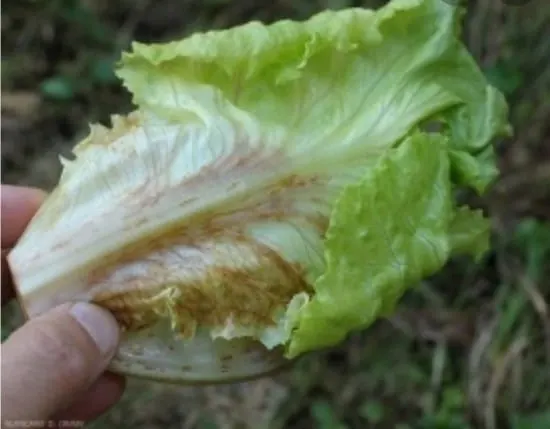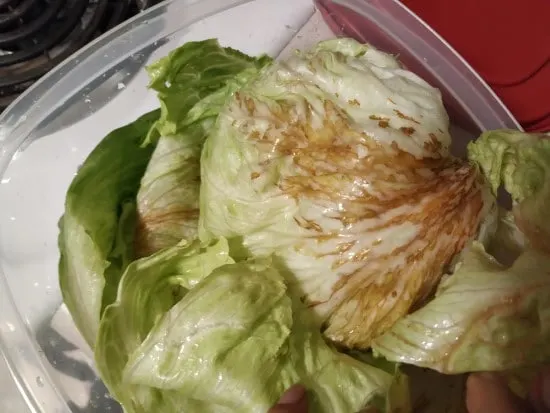Lettuce is an annual plant that belongs to the Aster family. It has many succulent leaves and is also used as one of the main ingredients in a wide variety of salads.
Lettuce is well known for its vibrant leaves that can turn red and green. The color of the lettuce is determined by the type you choose. In addition, some types of lettuce can have yellow or even golden leaves.
It is worth noting that lettuce prefers cool weather, which allows for rapid growth without seed formation. Lettuce is genetically programmed to produce seeds only when a specific temperature is exceeded.
Temperatures between 45 and 64 ° F are considered optimal. From the moment of planting to the moment of harvesting, it takes from 65 to 130 days.
However, it depends on the variety chosen and the time of year. Lettuce can grow up to 12 inches and has a weak root system, requiring frequent watering.

If you want to make a delicious salad, you can look for fresh green lettuce in your fridge. But once you find the lettuce has turn red, your appetite may go away.
In addition, you might wonder if it is safe to eat. Also, you might end up wondering Why Does Lettuce Turn Red. Well, if that is the case, you’ve come to the right place because we have the answer to this question.
Why Does Lettuce Turn Red?
Sometimes you can find red lettuce, and this can happen because of some reason. And we see everything at the moment. Before you do this, however, remember that some naturally red lettuces.
Typically, this happens because of a pigment called anthocyanins. But in addition to that, other external factors make lettuce turn red. Here are some of them.
1. Ethylene gas absorption
Do you usually see the trucks and cars roaming in the streets? Well, they are all and are known for exhaling a particular gas called ethylene gas.
Some healthy fruits such as bananas, peaches, and apples also release this gas. They produce more of this gas when compared to cars.
But what does this ethylene gas affect lettuce? Well, when this gas is released into the atmosphere, it tends to move freely. When the gas approaches the lettuce leaves, these leaves absorb this gas, which is poisonous.
When it enters the lettuce, the gas spreads all over the place and accelerates the aging process. That is when you start to see rusty red spots in the entire lettuce.
2. Green lettuce oxidation
However, if you see the red roots, you can be sure it is because of oxidation. Now you may be wondering how the leaves can oxidize. They definitely can, and that’s due to the iron inside.
There is a small amount of iron in the lettuce. And when that iron oxidizes in the air, it begins to affect the chlorophyll levels of the lettuce.
When the green pigment grows in lettuce, its color begins to take effect, and you will see the redness in lettuce. However, this does not happen during the night.
It takes about one week before you can see the red pigments. And the longer it stays like that, the darker it gets. All lettuces will slowly start to turn red and then very soggy.
3. Damage to healthy cells
Are you aware that red lettuce is not fresh? Yes, its anomaly is an indication of staleness. Essentially, what causes these nutritious vegetables to spoil?
We may get some scientific information, so be nice to us. The lettuce has an infinite number of cells. The biggest problem now is that healthy cells may be damaged if you do not care well.
This can happen for several reasons: too little water, too little sunlight, or even too much fertilizer. Whatever the reason, the result will be the same. Eventually, the cells will be damaged, and lettuce will start to turn red.
4. A cut by the rusty blade
Another thing that can make the lettuce turn red is a cut by a rusty blade. Cut half the lettuce and then put half of it inside the fridge.
When you cut the lettuce with a rusty knife, the rust in the blade will be transferred to lettuce. This will cause it to start to rot slowly.
The sad part is that blades are never 100% rust-resistant. Also, if you cut the lettuce regularly, the moisture inside will cover the knife. Even if the knife is clean, it will inevitably rust. One way to solve this problem is to cut the lettuce with a plastic knife.
Can The Red Lettuce Be Eaten?
The red lettuce is typically slimy and soggy. But that does not mean it cannot be eaten. If it doesn’t have a bad smell, you can eat it for lunch.
Nevertheless, you should know that red lettuce cannot be compared with green lettuce. They have the worst taste, and the nutritional value is less.
Before eating rusty red vegetables, make sure they are not entirely rotten. It would be best if you are very careful.

But if you want to preserve your salad, you can use a specific trick. It does not hurt if you are very careful. For this trick, push down firmly on the back of lettuce with your hand.
This will remove the seeds from the lettuce. And if you discard this part, the other part of the lettuce will remain fresh for a long time. This means you don’t have to worry for a while.
Uses of lettuce
Lettuce leaves contain up to 1.2% sugars, vitamins: C, B 1, B 2, B 6, E, P and PP, carotene, organic acids, salts of potassium, calcium, magnesium, phosphorus, iron, cobalt, copper, zinc, iodine, bioflavonoids, and phylloquinone, also, it contains alpha-tocopherol, citric and folic acids, lactucin, lactucerin, and lactuccin.
All these minerals and biologically active substances are included in the lettuce in a balanced form.
Due to the balance of all nutrients, lettuce has a good effect on digestion, the functioning of the liver, kidneys, and blood vessels and normalizes the body’s water balance.
For hypertension, diabetes mellitus, gout, and edema, fresh lettuce juice is helpful. Lactucin is part of the plant’s milky sap used for chronic bronchitis and asthma as a sedative and analgesic. Citric acid, which is also an integral part of lettuce juice, will add freshness and vigor.
Cabbage salads can retain beneficial properties at low temperatures for up to three weeks. But leafy ones do not have this property, and their leaves quickly wither and dry out. Therefore, fresh and head lettuce are equally helpful, but only head lettuce is suitable for future use.
Conclusion
Lettuce is a unique vegetable that can turn red sometimes. Some reasons for this include ethylene gas absorption, green lettuce oxidation, damage to healthy cells, and a cut by the rusty blade.
Be sure to grow lettuce in the right environment so that it does not change its color. And try to eat it before it turns red. This will give you the correct amount of nutrients your body needs and make a delicious salad.
